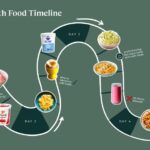The question often arises: “If you’re avoiding processed foods, why include cheese, especially cream cheese, in your diet? Isn’t it processed?” It’s a valid point, and understanding the nuances of food processing is key.
The reality is that even cooking can be considered a form of food processing. Unless you strictly adhere to a raw food diet, you’re likely consuming foods that have undergone some level of processing. Therefore, a more accurate approach might be to focus on avoiding highly processed foods. A reasonable guideline is to limit foods with more than five ingredients or those containing refined ingredients.
So, how does this apply to cream cheese and other dairy products? Let’s delve into what to look for when purchasing these items, particularly focusing on whether cream cheese is a processed food and how to choose healthier options.
Understanding Cheese: Minimizing Processing
Here’s a breakdown of key factors to consider when choosing cheese to minimize your intake of processed foods:
-
Organic: Opting for organic dairy products is generally a good idea. Unlike produce, you can’t simply peel or wash away potential contaminants from dairy, making organic a worthwhile choice when possible.
-
Block Form: Choose a block of cheese over pre-shredded varieties. Pre-shredded cheese often contains cellulose, an anti-caking agent that, in some cases, is derived from wood pulp. While the safety of cellulose isn’t the primary concern, it’s an unnecessary additive that you can avoid by grating your own cheese. Plus, freshly grated cheese often has a better texture, avoiding the “powdery” feel of pre-shredded options.
-
Color: Natural cheese is typically white, as it’s derived from milk or cream. Orange cheese gets its color from added natural color additives. While harmless, choosing white cheese aligns with a “less is more” approach to processing and ingredients.
-
Full Fat: As a general rule, avoid reduced-fat or non-fat dairy products. The processes used to reduce fat content often involve additional processing and additives. Full-fat versions are typically less processed and, arguably, more flavorful.
-
Grass-Fed: Look for cheese made from grass-fed cows. Cows are naturally meant to graze on grass, and when they do, their milk—and subsequently the cheese made from it—tends to be more nutritious. Check the packaging for “grass-fed” or “pasture-raised” labels.
Cream Cheese, Yogurt, and Beyond: Navigating Dairy Choices
Considering the above guidelines, where does cream cheese fit in, and how do you apply these principles to other dairy products?
-
Organic: As with all dairy, always choose organic when available.
-
Full Fat: Again, full-fat versions are preferable to low-fat or non-fat alternatives.
-
Plain: For yogurt, sour cream, and similar products, opt for plain varieties. Flavored versions often contain excessive amounts of sugar, salt, and oil. By choosing plain and adding your own flavors (such as homemade berry sauce or maple syrup), you control the ingredients and sweetness.
-
Minimal Ingredients: Always read the ingredient list, no matter the food. Fewer ingredients generally indicate less processing, as long as those ingredients are whole and recognizable. This is especially important when considering if cream cheese is a processed food. A high-quality cream cheese should have a short list of ingredients: cream, milk, salt, and possibly a stabilizer.
-
Grass-Fed: While it can be challenging to find, prioritize grass-fed options for all dairy products.
Is Cream Cheese Processed? A Closer Look
So, is cream cheese a processed food? The answer is yes, but the degree of processing varies significantly depending on the brand and ingredients. Cream cheese involves separating cream from milk, adding a culture to thicken it, and then processing it to create a smooth, spreadable texture. This is a level of processing, but it’s not necessarily “highly processed.”
The key is to choose cream cheese with minimal ingredients – ideally, just cream, milk, salt, and perhaps a natural stabilizer like carob bean gum. Avoid brands with added sugars, artificial flavors, or preservatives. By making informed choices, you can enjoy cream cheese as part of a balanced diet without compromising your commitment to avoiding highly processed foods.
Conclusion: Informed Dairy Choices for a Healthier Diet
Ultimately, the goal is to make informed choices about the foods you consume. While some dairy products undergo processing, focusing on organic, full-fat, plain varieties with minimal ingredients helps minimize your intake of highly processed foods. By understanding the nuances of food processing and reading ingredient lists carefully, you can confidently navigate the dairy aisle and enjoy your favorite foods in a healthier way. Remember to consider the cream cheese ingredients list to determine if the cream cheese is a processed food that fits your dietary goals.

